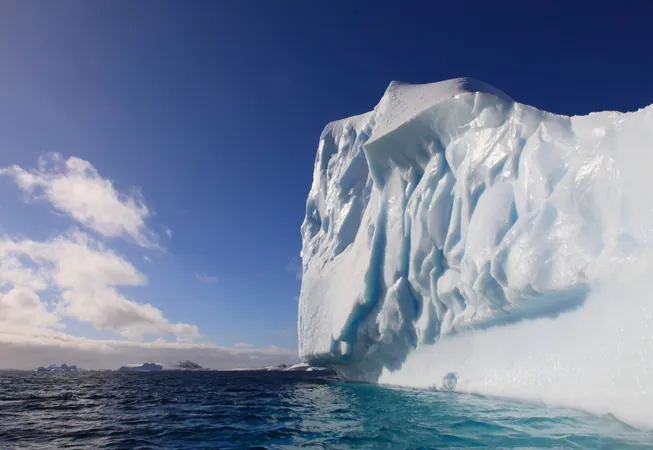
Antarctica's Melting Ice Shelves: A Ticking Time Bomb for Global Sea Levels!
2025-01-13
Author: Wei
Antarctica's Melting Ice Shelves: A Ticking Time Bomb for Global Sea Levels!
Antarctica, home to the largest ice sheet on our planet containing over 50% of Earth's freshwater, is at a precarious tipping point. The melting of its ice shelves, massive floating platforms of ice that protrude over the ocean, poses an alarming threat not just to the local environment but to global sea levels as well.
Recent studies reveal that many of Antarctica's ice shelves are experiencing significant thinning, primarily due to the warming ocean currents gnawing at them from below. This phenomenon has far-reaching consequences for ocean dynamics and, consequently, for sea levels worldwide.
The Filchner-Ronne Ice Shelf: Under Siege?
One of the focal points of this concern is the Filchner-Ronne Ice Shelf, which spans the Weddell Sea and is among the largest of its kind in Antarctica. Despite currently exhibiting relative stability, scientists are deeply concerned about the potential impact of warmer ocean currents that could encroach upon this crucial barrier.
Researching this delicate balance, a team led by N. Steiger from Sorbonne Université conducted in-depth ocean data analysis between 2017 and 2021. By utilizing advanced sensors placed on the seafloor and floating devices submerged in the water, they uncovered intricate interactions between ocean currents and the ice shelf that were previously poorly understood.
A Deep Dive into Ocean Dynamics
Earlier studies had isolated events, often assessing only specific locations, which resulted in incomplete understandings of the overall system. However, Steiger's team has revealed that warm water is not limited to a single pathway through the Filchner Trough but also utilizes smaller channels, each with varying influence year by year.
Research pinpointed notable summers in 2017 and 2018 when warmer waters surged into the area, significantly reducing floating sea ice that typically acts as a barrier. The reduced ice cover allows ocean temperatures to rise, setting the stage for warm water flows that could further impact the ice shelf.
Is the Ice Shelf in Immediate Danger?
While it is still uncertain whether the unusually warm water of 2017 and 2018 reached the edge of the Filchner-Ronne Ice Shelf, earlier data from 2013 indicated that warm water formations had indeed flowed towards the shelf during that year, potentially linked to specific wind patterns. This unsettling trend of warm water interaction poses significant risks, as less sea ice not only allows warm water to circulate freely but also facilitates direct encounters with the ice shelf itself.
Looking Ahead: The Future of Antarctica's Ice Shelves
The future of Antarctica's ice shelves hangs in the balance. The variability of ocean currents, along with changes in ice cover due to rising temperatures, may dramatically affect the stability of these vital structures. Researchers like Steiger emphasize the need for ongoing observation and sophisticated modeling to forecast how these gargantuan ice formations will react to accelerating climate change.
The implications are profound: Should the stability of Antarctica’s ice shelves continue to erode, the consequences could be catastrophic, leading to unprecedented rises in global sea levels that could reshape coastlines and displace millions.
With climate scientists urging continued monitoring and data collection, we stand at a crossroads regarding the health of our planet. The impending fate of Antarctica’s ice shelves could very well determine the future of sea levels around the world.
Stay tuned for more updates on this critical issue—the stakes have never been higher!
 Brasil (PT)
Brasil (PT)
 Canada (EN)
Canada (EN)
 Chile (ES)
Chile (ES)
 Česko (CS)
Česko (CS)
 대한민국 (KO)
대한민국 (KO)
 España (ES)
España (ES)
 France (FR)
France (FR)
 Hong Kong (EN)
Hong Kong (EN)
 Italia (IT)
Italia (IT)
 日本 (JA)
日本 (JA)
 Magyarország (HU)
Magyarország (HU)
 Norge (NO)
Norge (NO)
 Polska (PL)
Polska (PL)
 Schweiz (DE)
Schweiz (DE)
 Singapore (EN)
Singapore (EN)
 Sverige (SV)
Sverige (SV)
 Suomi (FI)
Suomi (FI)
 Türkiye (TR)
Türkiye (TR)
 الإمارات العربية المتحدة (AR)
الإمارات العربية المتحدة (AR)